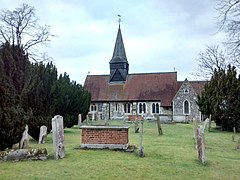Foots Cray
| Foots Cray | |
|---|---|
 All Saints Church |
|
| Foots Cray shown within Greater London | |
| OS grid reference | TQ472709 |
| London borough | |
| Ceremonial county | Greater London |
| Region | |
| Country | England |
| Sovereign state | United Kingdom |
| Post town | SIDCUP |
| Postcode district | DA14 |
| Dialling code | 020 |
| Police | Metropolitan |
| Fire | London |
| Ambulance | London |
| EU Parliament | London |
| UK Parliament | |
| London Assembly | |
Foots Cray (or Footscray) is an area of South East London, within the London Borough of Bexley. It borders the London Borough of Bromley and lies south east of Sidcup and north west of Swanley.
It took its name from Godwin Fot, a local Saxon landowner recorded in the Domesday Book of 1086, and from the River Cray that passes through the village. It lay on the old Maidstone Road (now bypassed by the A20 road) leading from London to north Kent. Until the 20th century, Foots Cray dominated the nearby, less ancient hill-top hamlet of Sidcup. The combined area was designated as the Urban District of Foots Cray in 1902. Soon, however, the two settlements' fortunes were reversed, as Foots Cray's traditional industries declined after the First World War, and Sidcup grew rapidly as a commuter town after a railway was built linking it to central London. In 1921 this change was reflected in the renaming of Foots Cray Urban District to Sidcup Urban District. In 1965 both areas became part of the London Borough of Bexley.
The estate of Foots Cray Place was rebuilt about 1754 for Bourchier Cleeve, on the site of the manor, as a Palladian mansion that was attributed to Isaac Ware; it was illustrated in this form in Vitruvius Britannicus iv (1777, pls. 8-10). Foots Cray Place was remodelled for Benjamin Harenc (1792) by the minor London architect Henry Hakewill, who further remodelled it in 1823 for Nicholas Vansittart, 1st Baron Bexley, who was Chancellor of the Exchequer. Further works were carried out for Lord Bexley by another London architect of equally modest reputation, John William Hiort, who also built Bexley's London house in Great George Street, Westminster. After a fire in 1949, it was demolished in 1950. Now only the stable block remains, but the grounds, known as Foots Cray Meadows, provide a valuable public green space in this south-eastern suburb of London. This 89-hectare park was formed in the early 19th century from two mid-18th-century landscaped parks. It is listed by English Heritage as a Grade II historic park and is a Local Nature Reserve. The "London LOOP" walk passes through Foots Cray Meadows on its way from Old Bexley to Sidcup Place and Petts Wood. There is some industry in an area next to the meadows and bordering the river.
...
Wikipedia

